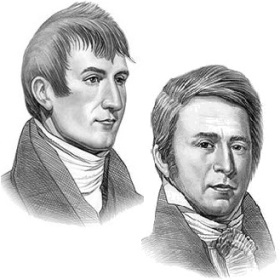|
5. The
black duck is about the size of the blue-winged teal; the color
of a dusky black; the breast and belly somewhat lighter, and
of a dusky brown: the legs stand longitudinally with the body,
and the bird when on shore, stands very erect: the legs and
feet are of a dark brown: it has four toes on each foot, and
a short one at the heel: the long toes are in front, unconnected
with the web: the webs are attached to each side of the several
joints of the toe, and divided by several sinews at each joint,
the web assuming in the intermediate part an eliptical form:
the beak is about two inches long, straight, fluted on the sides,
and tapering to a sharp point: the upper chop is the longest,
and bears on its base, at its junction with the head, a little
conic protuberance of a cartilagenous substance, being of a
reddish brown at the point: the beak is of an ivory color; the
eye dark. These ducks usually associate in large flocks, are
very noisy, and have a sharp shrill whistle: they are fat and
agreeably flavored; feed principally on moss and vegetable productions
of the water: they are not exclusively confined to the water
at all seasons, Captain Lewis has noticed them on many parts
of the rivers Ohio and Mississippi.
6. The divers are the same with those of the United States.
The smaller species have some white feathers about the rump,
with no perceptible tail, and are very acute and quick in their
motion: the body is of a reddish brown; the beak sharp, and
somewhat curved, like that of the pheasant: the toes are not
connected, but webbed, like those of the black duck. The larger
species are about the size of the teal, and can fly a short
distance, which the smaller but seldom attempt: they have a
short tail; their color is also a uniform brick reddish brown:
the beak is straight and pointed: the feet are of the same form
with the other species: the legs remarkably thin and flat, one
edge being in front. The food of both species is fish and flesh:
their flesh is unfit for use.
7. The blue-winged teal is an excellent duck, and in all respects
the same as those of the United States. One of our hunters killed
a duck which appeared to be a male. It was of a size less than
the duckinmallard; the head, the neck as low as the croup, the
back, tail, and covert of the wings were all of a deep fine
black, with a slight mixture of purple about the head and neck:
the belly and breast are white: some long feathers which lie
underneath the wings, and cover the thighs, were of a pale dove
color, with fine black specks: the large feathers of the wings
are of a dove color: the legs are dark; the feet are composed
of four toes, of which three are in front connected by a web:
the fourth is short and flat, and placed high on the heel behind
the leg: the tail is composed of fourteen short pointed feathers:
the beak of this duck is remarkably wide, and two inches in
length: the upper chop exceeds the under one, both in length
and width, insomuch, that when the beak is closed, the under
chop is entirely concealed by the upper: the tongue indenture
on the margin of the chops, are like those of the mallard: the
nostrils are large, longitudinal, and connected: a narrow strip
of white garnishes the base of the upper chop: this is succeeded
by a pale sky-blue color, occupying about an inch; which again
is succeeded by a transverse stripe of white, and the extremity
is a fine black: the eye is moderately large, the pupil black,
and of a fine orange color: the featherson the crown of the
head are longer than those on the upper part of the neck and
other parts of the head, which give it the appearance of being
crested.
Accounts of the Birds
Accounts of the Animals
|

